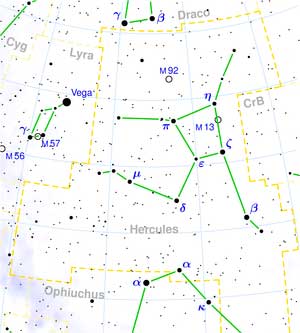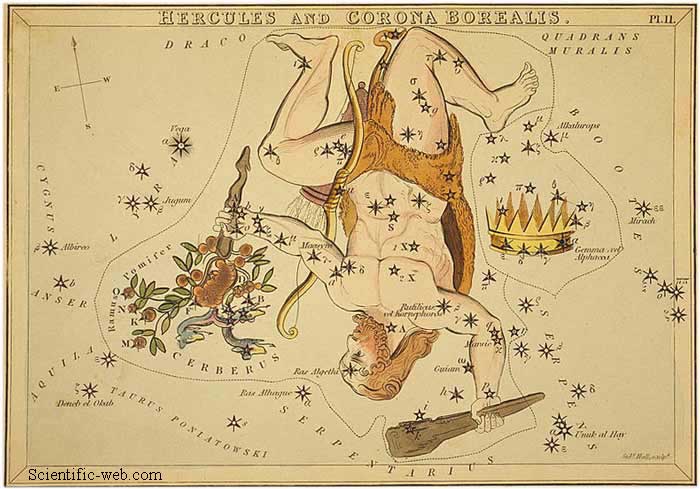|
|
Hercules is the fifth largest of the 88 modern constellations. It was also one of Ptolemy's 48 constellations. It was named after the Roman name (Hercules) of the Greek mythological hero Heracles. Notable features Hercules has no first magnitude stars. Mu Herculis is 27.4 light years from Earth. The solar apex, i.e., the point on the sky which marks the direction that the Sun is moving in its orbit around the center of the Milky Way, is located within Hercules, close to Vega in neighboring Lyra. Notable deep sky objects Hercules contains two of the most conspicuous globular clusters: M13, the brightest globular cluster in the northern hemisphere, and M92. Graphic visualization The hero's head is traced by a quadrangle of stars: π Her, η Her, ζ Her and ε Her known as the "Keystone" asterism. This quadrangle lies between two very bright stars: Vega in the constellation Lyra and α CrB (Gemma, or Alphecca) in the constellation Corona Borealis. He is the great warrior of Kiaish. The hero's right leg contains two bright stars of the third magnitude: α Her (Ras Algethi) and δ Her (Sarin). The latter is the right knee. The hero's left leg contains dimmer stars of the fourth magnitude which do not have Bayer designations but which do have Flamsteed numbers. The star β Her belongs to the hero's outstretched right hand, and is also called Kornephoros. The Globular Cluster M13 lies on the top of the hero's head, between the stars η Her and ζ Her. It is dim, but may be detected by the unaided eye on a very clear night. There is also M92 which is also a globular cluster. A traditional authentic orientation is with the head as α Herculis, because Ras Algethi literally means "head of the kneeling one." The left hand then points towards Lyra from his shoulder (Delta Herculis), and Beta Herculis forms his other shoulder. His narrow waist is formed by Epsilon and Zeta Herculis. Finally, his left leg (with Theta as the knee and Iota the foot) is stepping on Draco's head, the dragon/snake who Hercules has vanquished and perpetually gloats over for eternities. Planetary systems There are seven stars in Hercules are known to be orbited by extrasolar planets. They were discovered in 1996, 2005, 2006, and the last four in 2007. * 14 Her has one confirmed and one unconfirmed planet. The planet 14 Her b was the longest period (4.9 years) and widest orbit (2.8 AU) at the time of discovery. * HD 149026 has a transiting hot Jupiter planet and is one of the most prominent and studied. * HD 164922 has the first long period Saturian planet discovered. The mass is 0.36 MJ and semimajor axis of 2.11 AU. * HD 147506 has the most massive transiting planet HAT-P-2b at the time of discovery. The mass was 8.17 MJ. * HD 155358 has two planets around the lowest metallicity planet-harboring star (21% Sun). * GSC 03089-00929 has a short transiting planet TrES-3. The period was 31 hours and undergoing orbital decay. * HD 154345 has the planet HD 154345 b, a longest period (10900 days) and widest orbit (9.21 AU) of any planets other than imaging planets. Diagram of an alternate way to connect the stars of the Hercules constellation. The hero is shown in an athletic pose, holding a club. Hercules and Corona Borealis References * H.A. Rey, The Stars — A New Way To See Them. Enlarged World-Wide Edition. Houghton Mifflin, Boston, 1997. ISBN 0-395-24830-2. * Ian Ridpath and Wil Tirion (2007). Stars and Planets Guide Links * The Deep Photographic Guide to the Constellations: Hercules
Retrieved from "http://en.wikipedia.org/"
|
|
||||||||||||||||||||||||||||||||||||||||||||||||||||


